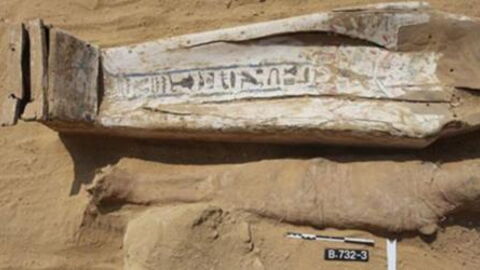A team of archaeologists have discovered a complex buried 30 metres underground that contains many burial chambers in the famous Saqqarah cemetery in Egypt. The best part of this discovery was the incredible mummifying workshop that researchers hope will be able to teach us a lot about the embalming techniques that were practiced in the Pharaoh’s era.
Discover our latest podcast
A very rare mask
Wooden coffins, a limestone sarcophagus and other treasures that they believed the royals would need on their journey to the afterlife when they died. These are just some of the treasures that archeologists managed to find whilst exploring the numerous burial chambers located tens of metres underground, in the cemetery in Saqqarah.
In one of these coffins, the team found a mummy wearing a silver gilt mask, the eyes adorned with calcite, obsidian and a third black stone that looks like onyx.
‘The finding of this mask could be called a sensation,’ said Ramadan Badry Hussein head of the Egyptian-German team from the University of Tübingen.
Due to a lot of lootings in Egypt over the past few centuries, no such mask had been excavated since 1939.
‘Very few masks of precious metal have been preserved to the present day, because the tombs of most ancient Egyptian dignitaries were looted in ancient times.’
The mask’s owner has been clearly identified by the team. According to the team, the mask belonged to the second priest of the mother goddess Mut and priest of Niut-shaes, an embodiment of the same goddess in serpent form. The man was probably alive during the 26th dynasty, between 664 and 404BC. The coffin with the full name is unfortunately damaged, but archaeologists have been able to determine that it did have the name Neith, the creative goddess of the universe.
Travel into the heart of embalming mysteries
In this complex, the team discovered a lot of funeral wells, but also a mummification workshop, overlooking one of the main wells. The area has two large basins that were likely used to dry mummies with natron (a mineral that is capable of absorbing moisture), and preparing the bandages that the mummies would then be wrapped in.
In another chamber that is even further underground, researchers found a lot of containers with the names of different oils, some of which may have been used to measure out quantities, as well as bowls and other substances used during the embalming process.
‘A gold mine of information,’ as Hussein describes it.
‘This [discovery] is so important as it is extensive. We have oils and measuring cups – all of them labelled… from this we can find the chemical composition of the oils and discover what they are,’ continues the specialist.
Mummies, shabti and ushabti faience figurines, alabaster canopic jars are some more of the additional treasures that the team found intact in the numerous burial chambers. This is a discovery like no other that is further proof of the complexity of this ancient civilization and will mean we can learn much more about these lost practices.















